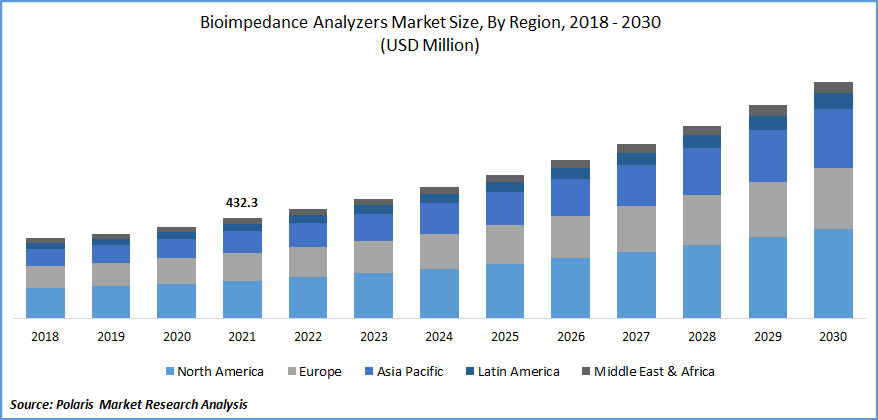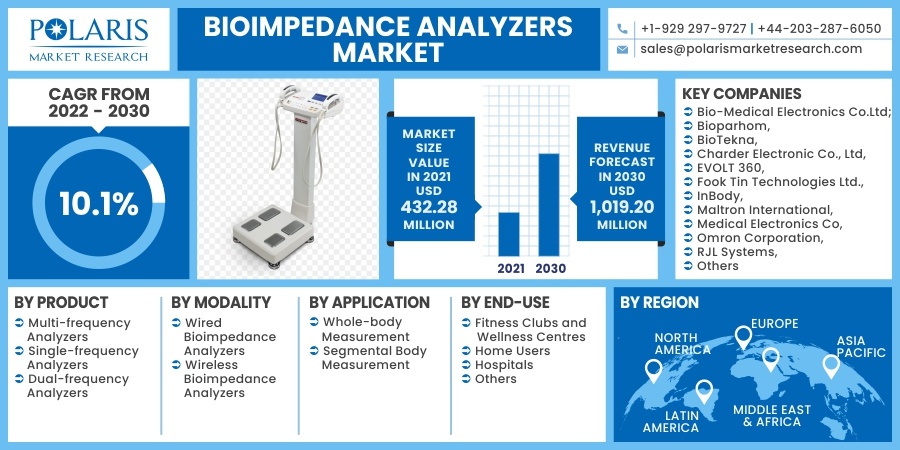
Bioimpedance Analyzers Market Share, Size, Trends, Industry Analysis Report, By Product (Multiple-frequency, Single-frequency, and Dual-frequency), By Modality, By Application, By End Use, By Region; Segment Forecast, 2022 - 2030
- Published Date:Jan-2022
- Pages: 110
- Format: PDF
- Report ID: PM2172
- Base Year: 2021
- Historical Data: 2018 - 2020
Report Outlook
The global bioimpedance analyzers market was valued at USD 432.28 million in 2021 and is expected to grow at a CAGR of 10.1% during the forecast period. The bioimpedance analyzers market demand is driven owing to the factors such as the rising number of government and organizational initiatives for promoting physical activity and healthcare coupled with growing responsiveness regarding the healthy lifestyle drives the bioimpedance analyzers industry demand. Also, the increasing volume of obese patients, as well as the rising prevalence of metabolic disorders, is primarily attributed to the market growth. Furthermore, growing spending on healthcare services, technological innovations in bioimpedance analyzers, and increasing fitness clubs along with sports rehabilitation centers are creating lucrative growth opportunities for market development around the world.
 Know more about this report: request for sample pages
Know more about this report: request for sample pages
The outbreak of COVID-19 exhibits a positive impact on the bioimpedance analyzers market. As per the World Health Organization (WHO), in Europe, about 95% of mortalities were caused in 60 and more year’s patients, and over 50% of worldwide deaths include people aged 80 years and older. Likewise, WHO reported that around every 8 in 10 deaths suffers from at least one health issue such as diabetes, CVD, and hypertension. Thus, it may create a positive influence on the bioimpedance analyzers industry.
The coronavirus lessens appetite and leads to the breakdown of muscle mass, which causes the occurrence of muscle mass loss and malnutrition. So, it is one of the significant factors for obese people, as they contain very low muscle mass. For instance, in Europe, practical guidance for the nutritional management of COVID-19 patients is provided by the European Society for Clinical Nutrition and Metabolism (ESPEN), which majorly emphasizes the significance of muscle mass. Hence, these factors propel the bioimpedance analyzers industry demand as assessment of body composition and muscle mass during hospitalization and also afterward are an extremely important factor for safeguarding the patient’s life.

Know more about this report: request for sample pages
Industry Dynamics
Growth Drivers
The growing incidence of lifestyle diseases acts as a major driving factor for market growth. In the modern era, changing the standard of living may lead to unhealthy lifestyles such as rising consumption of junk foods, sedentary work environments, as well as growing mobility automation. Thus, these factors are leading to the prevalence of various lifestyle diseases like diabetes, obesity, high blood pressure, etc. For instance, as per the Centers for Disease Control (CDC), the occurrence of obesity increased to 42.4 in 2019 from 30.5 in 2000.
Now, obesity is considered an epidemic across the globe. Nearly 57.8% of adults are likely to be categorized as the obsessed population, according to the World Health Organization (WHO). Moreover, obesity is termed as an epidemic majorly in the low and middle income as well as developed nations. Likewise, in 2019, the incidences of childhood obesity are grown by nearly 24% since 2000. Hence, these factors may fuel the adoption of the bioimpedance analyzer because of the rising need for precise measurement of the muscle, bone, and fat in the human body, which, in turn, propel bioimpedance analyzers market growth.
Report Segmentation
The market is primarily segmented on the basis of product, modality, application, end-use, and region
|
By Product |
By Modality |
By Application |
By End-Use |
By Region |
|
|
|
|
|
Know more about this report: request for sample pages
Insight by Organizational Size
Based on the product type, the multiple-frequency bioimpedance devices segment accounts for the largest revenue in the global bioimpedance analyzers market because these devices can calculate impedances at diverse frequencies. The growing popularity and awareness for the availability of multiple-frequency bioimpedance devices, along with the features of the devices such as it precisely computes the body composition, may support the segment demand. Furthermore, these devices are lightweight and small in size, which can easily operate by the house settings for monitoring the health of the entire family, further contributing to the segment growth across the globe.
The single-frequency bioimpedance devices are expected to show the highest CAGR in the near future. This growing need for measuring total body water and fat-free mass, as well as estimation of the extracellular and intracellular body water, may boost the segment growth among healthcare providers and patients. Hence, these factors may accelerate the segment demand over the approaching years.
Insight by End-Use
Among the end-use segment, the fitness club and wellness centers segment is recorded with the largest shares in 2020 and is expected to lead the market in the forecasting years. The rising awareness regarding health and fitness around the world is the key driving factor for the market demand. For some past decades, the presence of wellness centers and fitness clubs has increased significantly, resulting in the rising focus on health and fitness among the population, which, in turn, boosts the segment growth.
The home user segment is projected to be the fastest-growing segment across the market. The constant technological developments and growing adoption of bioimpedance analyzers are positively influencing the segment demand. The use of the bioimpedance analyzer is growing owing to assessing the body composition for maintaining health and wellness. This tool can easily operate without the help of a professional. Thus, it may act as a catalyzing factor for the segment demand in the near future.
Geographic Overview
Geographically, North America is accounted with the highest shares in the global market in 2020 and is likely to dominate the market over the upcoming scenario. The growing government initiatives for promoting a healthy lifestyle, escalating the number of fitness clubs and centers, increasing the obesity rate among the population may accelerate the market demand. For instance, in 2018, in the United States, obesity costs approximately USD 149 billion in annual medical expenditures as per the data published by the State of Obesity. The study observed that nearly half of these expenses were compensated by the financed Medicaid and Medicare programs. Therefore, the growing penetration of bioimpedance analyzers in North America is gaining significant prominence across the region.
Moreover, Asia Pacific is expected to grow at the highest CAGR across the globe in the approaching years. Due to the factors such as rising R&D activities along with emerging economies like China and India attributes to the regional market development. Moreover, increasing inclination towards the health and fitness activities, growing obese population as well as APAC offers significant opportunities to the venture capitalists and investors in the near future. Thus, the lesser number of physical activities and growing consumption of fast food are the factors that are creating lucrative opportunities in the approaching years.
Competitive Insight
Some of the major players operating the global market include Bio-Medical Electronics Co., Ltd., Bioparhom, BioTekna, Charder Electronic Co., Ltd, EVOLT 360, Fook Tin Technologies Ltd., InBody, Maltron International, Medical Electronics Co, Omron Corporation, RJL Systems, seca GmbH & Co. KG, SELVAS Healthcare, Tanita Corporation, Xiaomi, Guangzhou Beautylife Electronic Technology Co., Ltd.
Bioimpedance Analyzers Market Report Scope
|
Report Attributes |
Details |
|
Market size value in 2021 |
USD 432.28 million |
|
Revenue forecast in 2030 |
USD 1,019.20 million |
|
CAGR |
10.1% from 2022 - 2030 |
|
Base year |
2021 |
|
Historical data |
2017 - 2019 |
|
Forecast period |
2022 - 2030 |
|
Quantitative units |
Revenue in USD million and CAGR from 2022 to 2030 |
|
Segments covered |
By Product, By Modality, By Application, By End-Use, By Region |
|
Regional scope |
North America, Europe, Asia Pacific, Latin America, Middle East & Africa |
|
Key Companies |
Bio-Medical Electronics Co., Ltd., Bioparhom, BioTekna, Charder Electronic Co., Ltd, EVOLT 360, Fook Tin Technologies Ltd., InBody, Maltron International, Medical Electronics Co, Omron Corporation, RJL Systems, seca GmbH & Co. KG, SELVAS Healthcare, Tanita Corporation, Xiaomi, Guangzhou Beautylife Electronic Technology Co., Ltd. |
